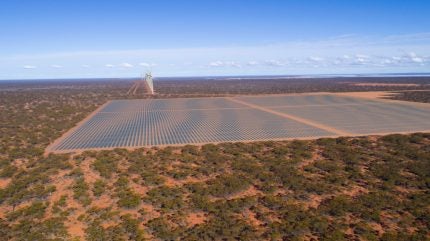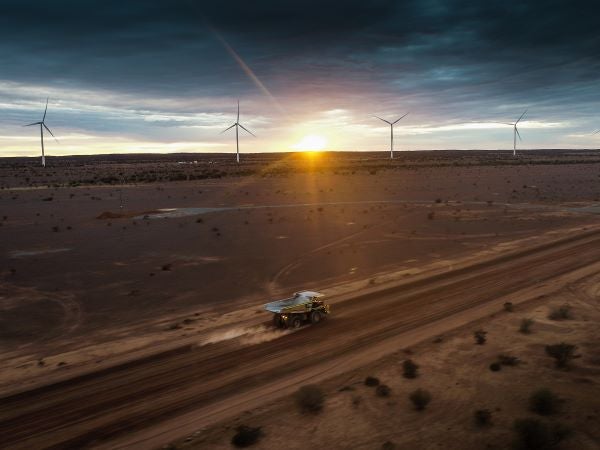
In March 2024, South African mining company Gold Fields approved a landmark renewables project at the St Ives mine near Kalgoorlie in Western Australia (WA).
The initiative – Gold Fields’ largest renewables project to date – will integrate 42MW of wind and 35MW of solar power capacity, which is expected to cover 73% of the mine’s electricity needs and cut carbon emissions by 50%.

Discover B2B Marketing That Performs
Combine business intelligence and editorial excellence to reach engaged professionals across 36 leading media platforms.
Simon Schmid, project director from Gold Fields, says construction of the site’s 60,000-panel solar farm (provided by Pacific Energy) is under way, while wind turbines are expected to be delivered in September 2025. Operations are set to begin at the start of next year.
The project is the latest example of a growing push to introduce renewable power to Australia’s mine sites as the nation pursues a net-zero emissions target date of 2050. Given the significant emission-reducing potential of renewable power, and Australia’s abundance of natural resources such as sun and wind, we look at whether this model could become the norm for Australia’s mines.
Building capacity at St Ives
The St Ives project is one of the largest of its kind at a mine site in Australia. While the potential of renewables is widely acknowledged, the initiative demonstrates its feasibility at scale and could be a valuable blueprint for others looking to do the same thing.
Daniel Jackson, managing director of renewables at Pacific Energy, echoes this point.

US Tariffs are shifting - will you react or anticipate?
Don’t let policy changes catch you off guard. Stay proactive with real-time data and expert analysis.
By GlobalData“The more we can demonstrate success in this space, the easier it is to assure miners and other energy-intensive operators that it is safe and reliable to transition to cleaner energy options with little to no impact on their operations,” he explains.
“Every success in this space demonstrates the legitimacy and reliability of renewables in Australia’s power systems,” he adds. “Projects like this demonstrate exactly what renewables work, and how and where they might be suited in our sun- and wind-abundant nation.”
Schmid agrees, emphasising the practical benefits of renewable energy in mining.
“Technology to develop these projects is readily available and provides a great opportunity to drive ESG [environmental, social and governance] commitments whilst providing security of supply and a reduced cost of energy for operations,” he says.
Indeed, much of the tech to integrate renewables already exists and while St Ives is a milestone project, it is not the only initiative of its kind. Globally, miners have been testing the waters of renewable power, and there are some examples that Australia could use as a guideline for tackling obstacles to deployment.
Global precedents for mine-site renewables
In 2023, AngloGold commissioned an independent power provider to construct and operate a 62MW hybrid wind and solar facility at its Tropicana gold mine in WA. Established under a ten-year contract, the facility is expected to reduce carbon emissions by more than 65,000 tonnes per year. The facility was recently completed, with operations scheduled to begin in earnest later this year.
Further afield, the Collahuasi and Gabriela Mistral copper mines in Chile successfully implemented large-scale solar installations that now supply 30–45% of their energy requirements. The project, first launched in 2013, was renewed in 2023 and is set to run until 2032.
Hanrong Huang, a researcher in photovoltaic and renewable energy engineering at the University of New South Wales, says Chile offers particularly valuable lessons for Australia due to shared challenges at mine sites.
“Chile’s relevance to Australia stems from comparable challenges: remote operations, substantial diesel costs and stringent reliability requirements,” he explains.
Similarly, he points to the Raglan mine in Quebec, Canada, which implemented a hybrid wind-hydrogen system in Arctic conditions that he said were “far more challenging than most Australian environments”.
“Across these examples, several common success factors emerge,” he says. “Strong executive leadership commitment; integration of energy strategy with broader sustainability objectives; progressive implementation allowing operational learning; and genuine collaboration between mining companies, technology providers, financiers and energy specialists.”
Australia’s renewables potential
With abundant natural resources and a mining industry in need of decarbonisation, Australia is uniquely placed to spearhead a renewables transition.
According to Huang, Australia’s mining regions have access to more than 2,000 hours of sunshine per year, allowing solar installation efficiencies that are 25–30% higher than global averages.
However, there are still certain factors that make some sites better suited to integrating renewable energy than others.
For one, sites need to have adequate available land that does not interfere with mining activities or future expansion. Huang says remote operations currently reliant on diesel-powered tools and infrastructure could see particular benefits.
“These sites frequently incur substantial fuel transport costs – often adding 30–40% to their energy expenses,” he adds. “For these operations, renewable adoption delivers both emissions reductions and significant operational savings.”

Sites with extended operational timelines of 10–15 years are also “good testbeds” for renewables, with this timeline allowing operators to realise the full economic return on infrastructure investments, according to Huang.
Of course, coastal and elevated sites would be particularly suited for wind power generation, with solar and wind together offering complimentary power.
“The natural generation profile of these technologies creates a synergistic relationship. Solar production peaks during daylight hours, while wind generation often strengthens during evening and overnight periods, enabling more consistent power supply,” says Huang.
Yet, despite the significant benefits of adopting renewables, hurdles do remain, with power reliability and storage scalability being key concerns.
Challenges of adopting renewables at mines
Unlike some other commercial operations, mine sites typically require consistent power, with even minor lags causing operational and financial losses.
In this context, having capacity for energy storage is key. While current battery storage solutions face some scalability issues in handling industrial-sized loads, research into alternative options is already under way.
Last year, the Australian National University identified 37 mine sites in Australia that could be converted into pumped hydro storage, with open-cut mining pits turned into reservoirs to hold water.
Such initiatives could provide power for the mines during operation and shore up energy reserves after closure, with researchers estimating the sites identified could deliver 540 gigawatt-hours of storage potential combined.
All renewable projects do, however, take time and money, with another challenge being return on investment.
Mining companies traditionally assess investments based on short payback periods of 2–4 years, whereas renewable projects often require 5–7 years to break even despite yielding greater long-term savings.
“This timing mismatch creates decision-making hurdles even when long-term economics clearly favour renewable adoption,” Huang says.
Skills shortages also present a problem, with few mining operations having internal renewable specialists.
To overcome these challenges, stronger collaboration between industry and government is seen as essential, particularly in establishing regulatory frameworks and financial incentives.
Paving the way forward
“Governments should establish frameworks that recognise mining operations’ unique circumstances,” says Huang. “Extending renewable energy incentive schemes to remote industrial applications would significantly improve project economics – currently, many such programmes primarily benefit grid-connected systems.”
Similarly, Jackson says the industry is expecting to see “improved government policy and infrastructure” to support the renewable transition.
“Particularly in the Pilbara, [we may see] partnerships between miners, power providers and government to overcome some of the cost barriers,” he adds.
From the perspective of mining companies, a gradual integration approach could prove a more effective means of demonstrating the viability of renewable technologies, rather than a mass overhaul.
Gold Fields, for example, successfully deployed an 86MW solar-plus-storage system at its South Deep Mine in South Africa using a staged approach, a model that could be replicated in Australia.
According to Huang, hybrid systems could supply as much as 60–80% of a mine’s energy requirements and provide emission reductions of up to 95% compared with diesel-only generation. This, he says, has the potential to provide “genuine transformation rather than incremental improvement”.
Another potential strategy is to implement energy-flexible operations, scheduling energy-intensive processes with peak renewable generation to optimise efficiency.
Microgrids are also emerging as a reliable solution for miners, combining solar, wind, battery storage and backup generation to ensure stable power supply. Hybrid versions combine solar, wind and battery storage to provide mines with consistent power, bridging intermittency gaps.
As renewable energy and storage technologies such as these continue to develop, cost barriers will lower and industry know-how will rise, with projects like St Ives set to grow more commonplace.
“Electrification of the mining sector is already well in play here in Australia,” says Jackson. “We expect to see renewable energy playing a significant role in meeting the growing energy needs of miners, and because wind and solar are so abundant, it makes sense to capitalise on them.”
“As the costs for both renewables and enablers like big batteries continue to drop, we can make a strong environmental and economic case for clients to adopt clean energy solutions.”





